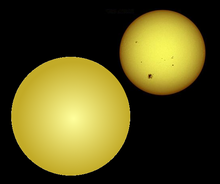| Observation data Epoch J2000 Equinox J2000 | |
|---|---|
| Constellation | Cygnus |
| Right ascension | 19h 47m 20.9380s[1] |
| Declination | +48° 14′ 23.759″[1] |
| Apparent magnitude (V) | 13.8 |
| Characteristics | |
| Apparent magnitude (J) | 12.001±0.021[2] |
| Apparent magnitude (H) | 11.706±0.019[2] |
| Apparent magnitude (K) | 11.634±0.019[2] |
| Astrometry | |
| Proper motion (μ) | RA: 0.935(11) mas/yr[1] Dec.: 8.458(12) mas/yr[1] |
| Parallax (π) | 1.7108 ± 0.0102 mas[1] |
| Distance | 1,910 ± 10 ly (585 ± 3 pc) |
| Details | |
| Mass | 1.209 M☉ |
| Radius | 1.391 R☉ |
| Temperature | 5647 K |
| Age | 3.8 Gyr |
| Other designations | |
| Database references | |
| SIMBAD | data |
| KIC | data |
Kepler-6 is a G-type star situated in the constellation Cygnus. The star lies within the field of view of the Kepler Mission, which discovered it as part of a NASA-led mission to discover Earth-like planets. The star, which is slightly larger, more metal-rich, slightly cooler, and more massive than the Sun, is orbited by at least one extrasolar planet, a Jupiter-sized planet named Kepler-6b that orbits closely to its star.
